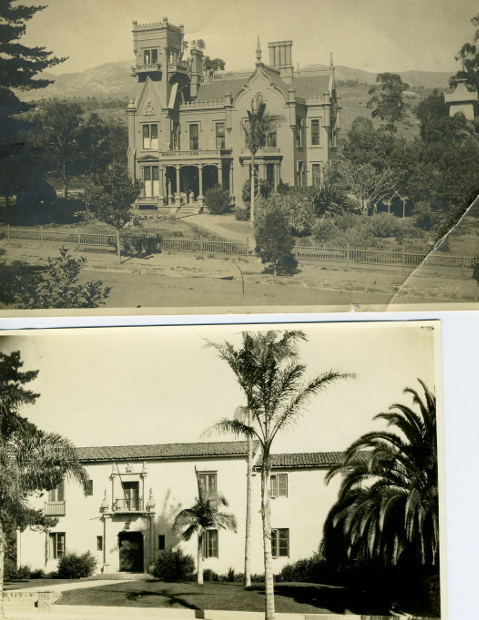James W. Calkins House
Elizabethan Wonder Now the University Club

This home, built for James W. Calkins about 1878, was located at 1332 Santa Barbara Street. The house was remodeled top to bottom in 1922 in the Spanish Colonial Revival style and today is home to the University Club.
The look of the original building was, apparently, a matter of taste. One critic called it “a monstrosity of towers, battlements, bay windows, porticos, and scrollwork.” Yet a reporter for the Morning Press in 1881 wrote the house was “unsurpassed for beauty by any residence in the city. It is built after the Elizabethan style of architecture, and those familiar with the pleasant peculiarities of that style will find them all reproduced in this beautiful home.”
Little is known about the owner of the house, J.W. Calkins. About the time the house was built, Calkins was vice president of the First National Gold Bank, and he went on to become president of the bank. Calkins also dabbled in ranching. He leased part of Rancho Corral de Quati in the Santa Ynez Valley and owned a portion of the adjoining Rancho La Zaca, most probably as an investment.
Calkins was a member of the Santa Barbara School Board. He served as an officer of the Santa Barbara Natural History Society and reportedly owned a shell necklace that had belonged to the “Lone Woman” of San Nicolas Island. He was an avid horticulturist, and the garden of his Santa Barbara Street property was among the most elaborate in the city. The orchards included 22 apple trees, seven pear trees, six peaches, 12 bananas, 11 orange trees, and seven figs. The vineyard contained 15 varieties of grapes, and the profusion of flowers and plants included 30 types of ferns and 20 kinds of fuchsias.
The house itself was impressive: five bedrooms, five baths, and servants’ quarters. The woodwork inside was gorgeous, highlighted by an elegant central staircase. The Calkins family eventually sold the house, and it passed through a number of owners’ hands until the University Club became interested in the property.
The club was founded in 1919 and held its first meetings in the Belvedere Hotel, formerly the Potter Hotel. The club relocated to a house at 25 East Micheltorena Street until the old Calkins house became available in the spring of 1922. The club purchased the property for $27,500 and engaged the architectural firm of Soule, Murphy, and Hastings to remodel the house. Winsor Soule and John Frederick Murphy were both members of the club. The new clubhouse was dedicated in March 1923.
The remodel was dramatic. One reporter wrote, “Even the oldest inhabitant wouldn’t recognize [the Calkins house] now. It’s been worked over, and added to, and re-roofed and stuccoed, and metamorphosed …” Much of the woodwork was retained, including the grand staircase. The upstairs was taken over as apartments for unmarried members. These members paid $80 a month for an apartment and three meals a day. The club’s new dining room was large enough to hold all 228 members in one sitting.
With all the alterations made through the decades, the University Club of today is a far cry from the “beautiful home” that J.W. Calkins built over 130 years ago.
Michael Redmon, director of research at the Santa Barbara Historical Museum, will answer your questions about Santa Barbara’s history. Write him c/o The Independent, 122 W. Figueroa St., Santa Barbara, CA 93101.



